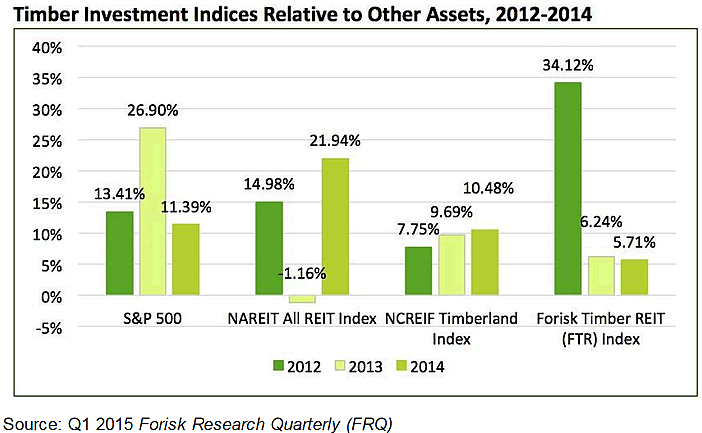Investors looking to add timberlands to their portfolios and timberland-owning REITs looking to grow their asset base both face the challenge of identifying attractive, investable candidates from a market with limited supplies of quality properties. While the U.S. has more trees “than you can shake a stick at,” it does not have an unlimited supply of operationally viable forestland tracts. When evaluating investment strategies and relative competitive advantage, I watch this closely as it speaks to growth and returns. What opportunities exist for specific timber REITs or timberland investment managers (TIMOs) to grow? It’s a competitive environment and investors and firms want to acquire quality assets without sacrificing long-term returns.
Timberland Investment Performance in 2014
Timberland investment vehicles, while continuing to generate positive returns, lagged in both the S&P 500 and the publicly traded real estate sector. The National Council of Real Estate Investment Fiduciaries (NCREIF) reported 2014 total returns for private U.S. timberlands of 10.48%, which marks the fourth consecutive year of improved returns. The figure below compares by year, for 2012 through 2014, the performance of indices tracking the S&P 500, all publicly traded real estate investment trusts (NAREIT), private timberlands (NCREIF) and publicly-traded timberland-owning REITs (Forisk Timber REIT Index (FTR)). Timber REITs in the FTR Index for 2012 and 2013 include Plum Creek (PCL), Potlatch (PCH), Rayonier (RYN) and Weyerhaeuser (WY). The 2014 figures also include CatchMark Timber Trust (CTT).

Timber REITs
Timberland owning real estate investment trusts (REITs) work to achieve growth in at least two primary ways. First, they look to optimize the performance of the assets in their existing portfolios. These assets fund dividends, debt service and operations. Second, they look for growth opportunities that improve the overall quality of the portfolio of assets and translate this into dividend growth for shareholders. Portfolio improvement is a strategy of selling bottom-tier or “less desirable” or “less strategic” assets and replacing them with higher-quality (timberland) assets. This recipe is true for timberland portfolios generally, for REIT firms generally, and for timber REITs explicitly.
For 2014, the FTR Index of timber REITs showed positive returns because Weyerhaeuser, the only firm with meaningful positive stock price appreciation, accounts for 57% of the timber REIT sector’s market capitalization. Including dividends, sector level total returns were 9.94% for the year. Overall, performance lagged from slower housing markets and the associated muted timber pricing and volumes in core grade categories. In short, lower demand for lumber resulted in lower demand in logs resulted in lower than expected cash flows. This made maximizing the existing assets in the current market less impactful to results.
This content may not be used or reproduced in any manner whatsoever, in part or in whole, without written permission of LANDTHINK. Use of this content without permission is a violation of federal copyright law. The articles, posts, comments, opinions and information provided by LANDTHINK are for informational and research purposes only and DOES NOT substitute or coincide with the advice of an attorney, accountant, real estate broker or any other licensed real estate professional. LANDTHINK strongly advises visitors and readers to seek their own professional guidance and advice related to buying, investing in or selling real estate.










Add Comment